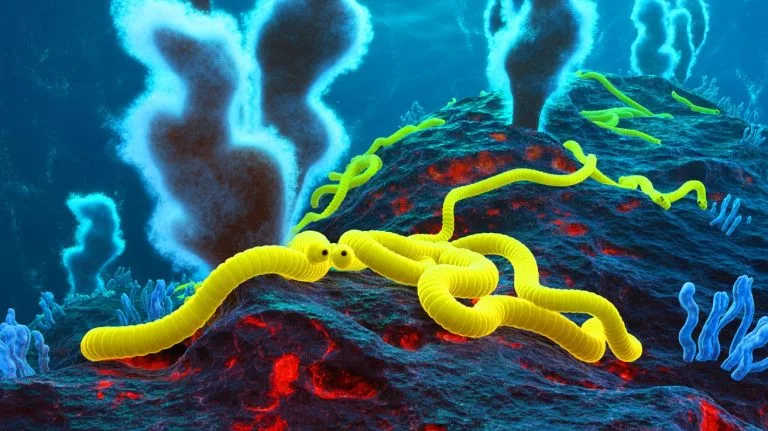| IN A NUTSHELL |
|
In a pioneering expedition to the depths of the Pacific Ocean, an underwater robot has revealed startling insights into the survival mechanisms of life in one of Earth’s most extreme environments. The discovery centers around Paralvinella hessleri, a species of worm thriving in the toxic and scalding conditions of hydrothermal vents. These findings, published in a study led by Dr. Hao Wang, highlight the extraordinary adaptability of life forms in environments previously deemed uninhabitable. This research not only expands our understanding of biological resilience but also opens potential avenues for innovations in environmental science and medicine.
Hydrothermal Vents: The Extreme Environment of the Deep Ocean
Hydrothermal vents are unique geological formations located along the ocean floor. They occur where tectonic plates shift, allowing volcanic activity to heat the surrounding water. These vents release superheated water mixed with a range of toxic chemicals like hydrogen sulfide, arsenic, and methane. Such harsh conditions typically render these areas uninhabitable, yet they are home to the resilient Paralvinella hessleri worms. These organisms thrive in an environment akin to the most extreme conditions found on Earth.
The worms’ ability to survive in this setting is a testament to nature’s adaptability. Hydrothermal vents are often compared to extraterrestrial environments due to their inhospitable nature. Yet, Paralvinella hessleri has evolved mechanisms that allow it to withstand these challenges. For instance, these worms can live just centimeters away from scalding fluids and toxic gases, showcasing their remarkable resilience.
The Discovery of Paralvinella Hessleri and Its Stunning Survival Mechanisms
The recent study leveraged a remotely operated vehicle (ROV) to explore the depths of a hydrothermal vent system in the West Pacific. During this exploration, researchers stumbled upon the bright yellow Paralvinella hessleri worms. Their vibrant color starkly contrasted with the dark and barren landscape of the vent walls, creating a striking visual.
Dr. Hao Wang, the study’s lead author, shared his surprise and awe at this discovery. He described the worms as “unlike anything” he had ever encountered, their vivid hues standing out against the surrounding environment. The color, however, is not merely an aesthetic trait; it plays a crucial role in the worms’ survival strategy, contributing to their unique adaptation mechanisms.
A Close Look at the Chemical Warfare Strategy: How These Worms Survive
The survival of Paralvinella hessleri hinges on its ability to manage the toxic substances prevalent in its environment. The worms have developed a sophisticated mechanism to detoxify arsenic and hydrogen sulfide, substances lethal to most life forms. The researchers found that the worms accumulate arsenic in their skin cells, a process that would generally be fatal.
However, Paralvinella hessleri has found a way to neutralize the arsenic by combining it with sulfur from the water. This reaction creates orpiment, a yellow mineral that is non-toxic and gives the worms their distinctive color. As Dr. Wang explains, understanding these mechanisms could lead to new approaches for dealing with environmental toxins, offering potential applications in fields like environmental remediation and medicine.
A Glimpse into the Molecular Mechanisms: What Science Still Needs to Discover
While the discovery of Paralvinella hessleri’s detoxification strategy is groundbreaking, the molecular processes involved remain largely unexplored. Scientists are eager to understand the biological pathways that allow these worms to neutralize arsenic. This understanding could reveal new insights into biological resilience and adaptability.
Researchers are particularly interested in how these worms absorb and process sulfur and arsenic. The mechanisms they use could offer insights applicable to other organisms, including humans. The parallels between the worms’ detoxification methods and human water filtration systems suggest there may be advanced biological processes at work. Further research could uncover these processes, potentially leading to groundbreaking applications in various scientific fields.
The remarkable discovery of Paralvinella hessleri and its survival mechanisms in hydrothermal vents challenges our understanding of life’s adaptability. As scientists continue to explore these extreme environments, they may unlock new insights into resilience and adaptation. What other secrets might the depths of our oceans hold, waiting to be uncovered by the next pioneering research expedition?
Did you like it? 4.6/5 (27)






Wow, nature never ceases to amaze me! How do these little guys even survive such extreme conditions? 🤯
Wow, nature never ceases to amaze! Who knew worms could eat arsenic and survive? 🤯
I’m curious, could this discovery help us develop new ways to clean up toxic waste on land?
Can these worms actually help clean up arsenic contamination? That would be incredible!
Thank you for sharing such an intriguing find! It’s incredible how life adapts to harsh environments. 🌍
This is fascinating, but how exactly do they turn arsenic into harmless yellow crystals?
Does anyone else think these worms sound like something out of a sci-fi movie? 🚀
Are there any other organisms that can survive conditions like these? 🤔
Thanks for the informative article! I never knew anything could survive in such harsh conditions.
Imagine if we could use these worms to detoxify polluted waters! That would be groundbreaking.
How do they know the worms aren’t just surviving by sheer luck? 🤔
What kind of technology was used to explore these hydrothermal vents?